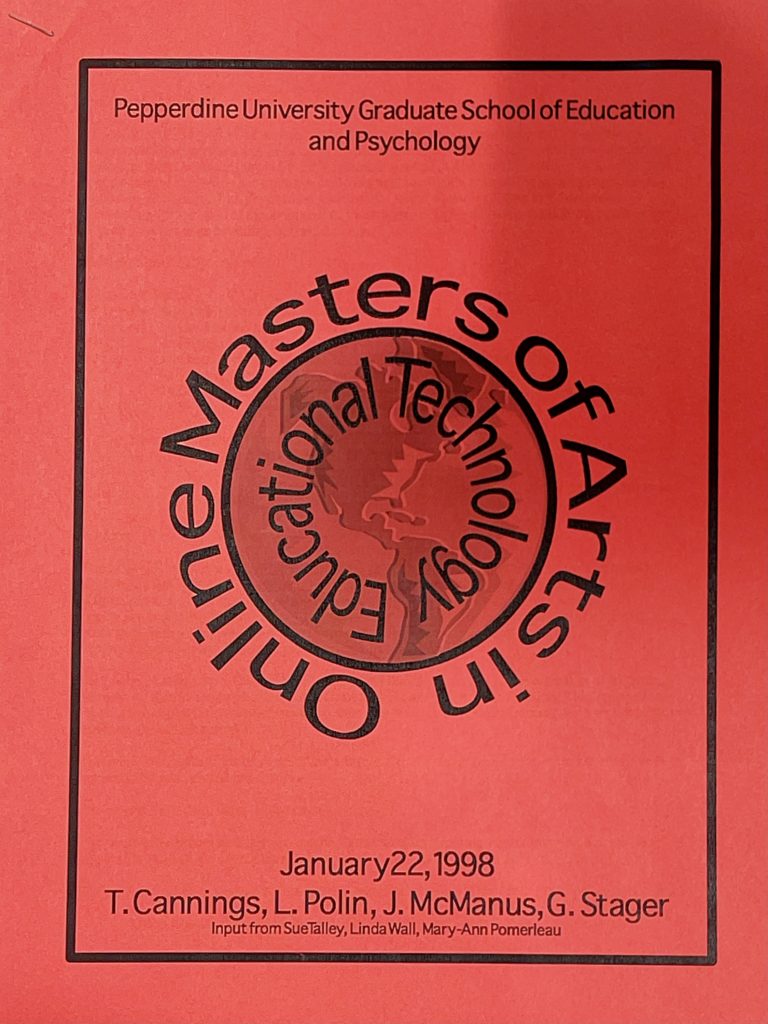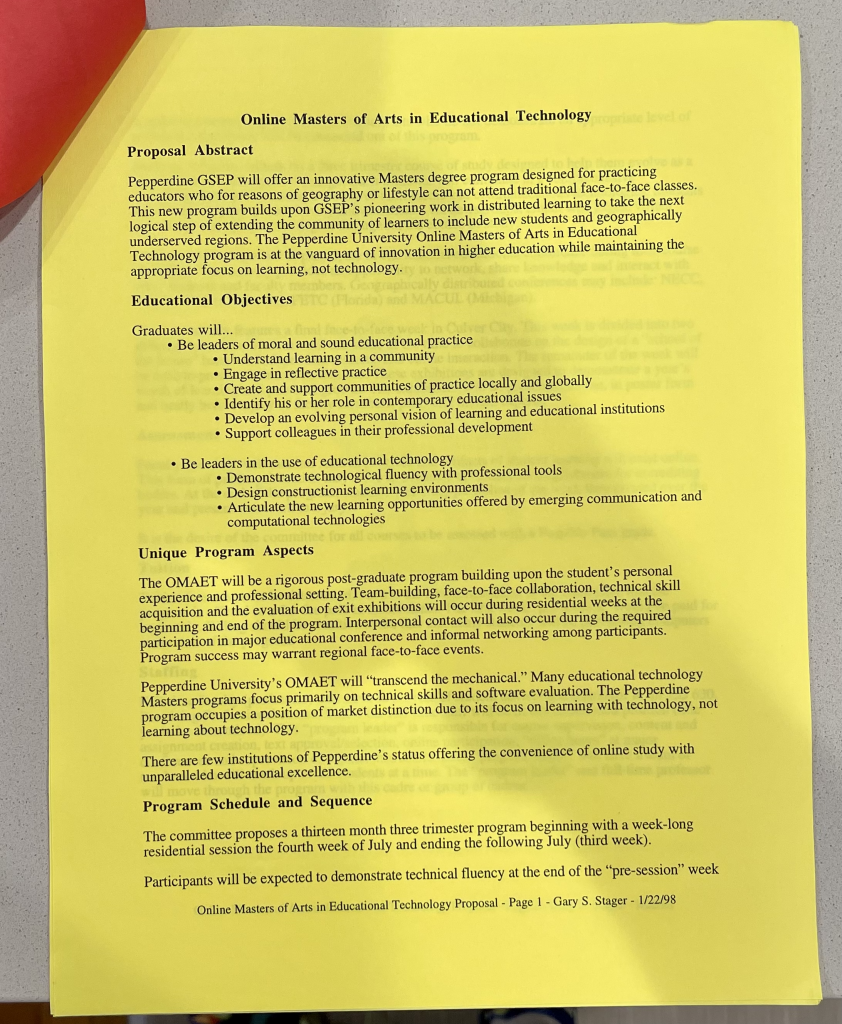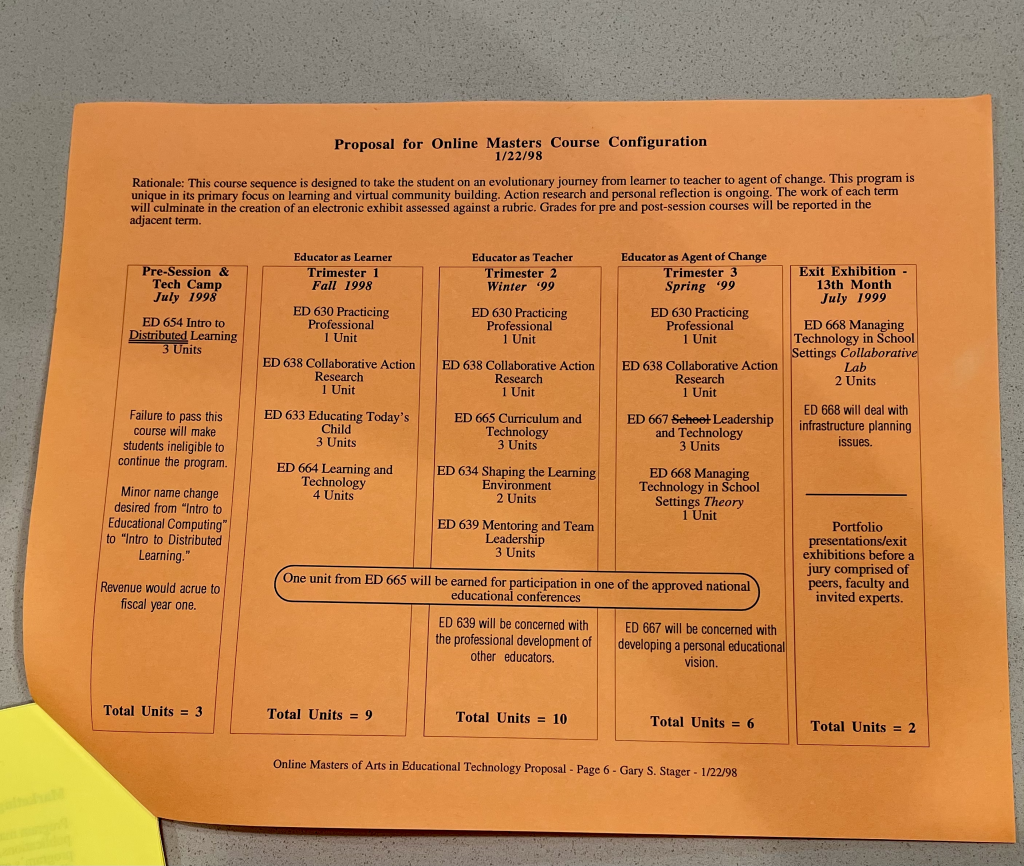I just found the 1998 pitch I created for Pepperdine’s Online Masters of Arts in Educational Technology degree program printed on the original DayGlow construction paper belonging to my kids. The tale behind the document is worth recounting.
I first became aware of Pepperdine University in the past 1970s when they were the setting for ABC’s Battle of the Network Stars. Then Pepperdine hosted two Logo conferences I attended in the late 1980s. When I moved to Los Angeles in the 1993, I began many of years of working as an adjunct, prior to being a Visiting Professor for a few years, beginning around 2008.
Pepperdine was already dabbling in online teaching by the summer of 1997 when I told the late great Terry Cannings that this Web thing was going to blow-up and in order to maintain our position of market leadership, we needed to create an online MA program in educational technology ASAP. Associate Dean Cannings called me a charlatan and that was that until December of that year when he summoned me to say, “Let’s discuss that online MA idea again after the holidays.”
If you think that was fast…
Fast forward to January 1998. Terry, Linda Polin, Jack McManus and I talked about how we could bring constructionism and learning-by-doing online with a goal for the educational experience to be more personal, intimate, project-based, and social than found in a typical graduate school. All of us had been on the Internet since the early ’80s and knew that learning online could be more, not less humane. Our work was inspired by Dewey, Vygotsky, Papert, Lave & Wenger. A meeting was arranged to meet with the Dean in her office on the big campus in Malibu (all of the work of the Graduate School of Education and Psychology was at satellite campuses). The night before the January 22nd pitch meeting I had a moment of panic when I realized that my colleagues, an Associate Dean and two full professors, were unlikely to prepare anything in writing necessary to “sell the dream.”
Despite being an adjunct rumored to be unpopular with the Dean, I stayed up and wrote an executive summary including the pitch, curriculum outline, marketing plan, personnel, flexible cadre organization, and hybrid format that would include three face-to-face events at the beginning, middle, and end of the program. This “hybrid” model made the prospect of an online degree program less scary because in the parlance of higher-eduction, we were now 60/40 (online/f2f) and thirteen months (which equalled two years according to the university). The proposal I whipped up included a pictogram illustrating how the program could expand or contract while maintaining quality and revenue.
When it came time to print copies of the proposal, I grabbed my kid’s brightly colored printer paper and printed each section of the document in a different color and stapled the packets together. The following morning I drove to Malibu, walked into the conference room, and handed the Dean the document I created. She glanced at it, saw the colored section, and said, “You must have worked very hard on this.”
The meeting went reasonably well and the Dean’s interest was piqued. She asked “This sounds interesting. What year are you thinking of launching such a program?” Once again, I overestimated the speed of educational change and replied, “If we don’t go this summer, we’re going to blow the opportunity.” The Dean smiled nervously and sent us on our way. Along with Professors Polin and McManus we had the new program accredited by May and a cohort of students on campus for “VirtCamp” in early July.
The Online Master of Arts in Educational Technology at Pepperdine University ran relatively unchanged, except for a name change swapping “educational” for “learning” for close to two decades and still exists in some form.



Veteran educator Gary Stager, Ph.D. is the author of Twenty Things to Do with a Computer – Forward 50, co-author of Invent To Learn — Making, Tinkering, and Engineering in the Classroom, publisher at Constructing Modern Knowledge Press, and the founder of the Constructing Modern Knowledge summer institute. He led professional development in the world’s first 1:1 laptop schools thirty years ago and designed one of the oldest online graduate school programs. Gary is also the curator of The Seymour Papert archives at DailyPapert.com. Learn more about Gary here.
